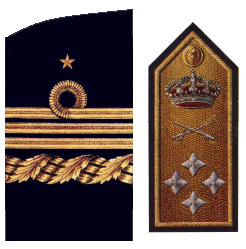 W
WAdmiral general also called general admiral, is a four-star flag officer and the second highest possible rank in the Spanish Navy. Admiral general ranks immediately above admiral and is equivalent to a General of the Army and a General of the Air. There is not equivalent in the Civil Guard or in the Spanish Navy Marines; in both cases the top rank is Lieutenant general.
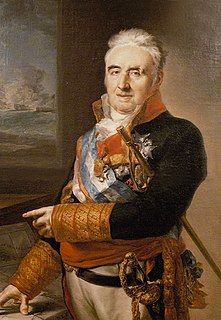 W
WIgnacio María de Álava y Sáenz de Navarrete was a Spanish naval officer, present at the Battle of Trafalgar.
 W
WAlfonso Jofré Tenorio was the Admiral of Castile from 1314 until his death. He participated in a war against the Emirate of Granada in 1316, and led a blockade in 1326 during which he defeaed the Granadan-Marinid fleet. In 1333 he participated in the defense of Gibraltar against a Marinid-Granadan siege, but Castile was defeated and he signed a 1334 treaty that formalised the cession of the town. He died in a naval battle against the Marinid fleet of Abu al-Hasan Ali on the Strait of Gibraltar.
 W
WFadrique de Toledo or Fadrique Álvarez de Toledo y Mendoza, 1st Marquess of Valdueza, was a Spanish noble and admiral. He was a Knight of the Order of Santiago and Captain General of the Spanish Navy at the age of 37.
 W
WGarcía Álvarez de Toledo y Osorio, 4th Marquess of Villafranca del Bierzo, was a Spanish general and politician.
 W
WAdmiral Ramón Auńón y Villalón was a Spanish naval officer who served as the Minister of the Navy during the Spanish–American War, replacing Segismundo Bermejo y Merelo. He had joined the Armada at the age of 15 and fought in conflicts in Africa and Cuba, later commanding a battleship and gaining a reputation for being an efficient administrator. Upon becoming Minister of the navy, Auńon was forced to make a decision of whether or not Admiral Pascual Cervera y Topete's squadron in Santiago de Cuba should sortie or not. He ultimately decided in favor, resulting in the Battle of Santiago de Cuba. Afterwards, he would serve as a member of the Congress of Deputies and as civil governor of the Province of Barcelona.
 W
WAntonio Azarola y Gresillón was a Spanish Navy officer, rear admiral of the Spanish Republican Navy. He was executed by firing squad on 4 August 1936 at the Ferrol Naval Base in Galicia, NW Spain, by rebel Navy officers for refusing to join the coup of July 1936 against the Spanish Republic that triggered the Spanish Civil War.
 W
WAdmiral Juan Bautista Aznar-Cabañas was the Prime Minister of Spain from the resignation of Dámaso Berenguer y Fusté on to the deposition of King Alfonso XIII and the proclamation of the Spanish Second Republic on April 14, 1931.
 W
WAntonio Barceló y Pont de la Terra was a Spanish mariner, lieutenant general of the Spanish Royal Armada.
 W
WÁlvaro de Bazán, 1st Marquess of Santa Cruz, GE, KOS, was a Spanish admiral. He was never defeated, a remarkable achievement in a fifty-year long career. His personal galley, La Loba, thus called by her golden figurehead, was feared by Spanish enemies and regarded with hope amongst Spanish sailors and allies.
 W
WDon Álvaro de Bazán, called the Elder (1506–1558) was a Spanish naval commander from an old Navarrese noble family who received several nobilary titles such as the rank of Admiral of Castile, Marquis del Viso, and General-Captain of the Galleys of Spain. He was the father of Álvaro de Bazán, 1st Marquis of Santa Cruz, who surpassed him in fame. At the age of eight his son was appointed "Military Governor and captain of the fortress and city of Gibraltar". His command however was via his father. It has been speculated that this unusual appointment was intended to show Charles V's confidence but Bazán the Elder did not share that confidence and he suggested to no effect that Gibraltar's Line Wall Curtain be extended to the southern tip of the rock.
 W
WAdmiral Segismundo Bermejo y Merelo was a Spanish naval officer who served as chief of staff in the Spanish Navy and Minister of the Navy during the Spanish–American War. He was most notable for his role in dispatching Rear Admiral Pascual Cervera y Topete, in command of a squadron of four cruisers and three destroyers, to Cuba in May 1898. It set up the conditions for the naval Battle of Santiago de Cuba. Bermejo himself was forced to resign as naval minister after the defeat of the Spanish Pacific Squadron at the Battle of Manila Bay by the U.S. Navy, and he died a year later.
 W
WAdmiral Manuel de la Cámara y Livermoore was a Spanish naval officer. He saw service in many of Spain′s wars of the second half of the nineteenth century and is most notable for commanding a relief squadron that made an abortive attempt to relieve Spanish forces in the Philippine Islands during the Spanish–American War.
 W
WLuis Carrero Blanco was a Spanish Navy officer and politician, who served as Prime Minister from June 1973 until his assassination in December of that year. He participated in the Rif War, and later the Spanish Civil War, in which he supported the Nationalist faction.
 W
WAdmiral Pascual Cervera y Topete was a prominent Spanish naval officer with the rank of Almirante (admiral) who served in a number of high positions within the Spanish Navy and had fought in several wars during the 19th century. Having served in Morocco, the Philippines, and Cuba, he went on to be Spain's naval minister, chief of naval staff, naval attaché in London, the captain of several warships, and most notably, commander of the Cuba Squadron during the Spanish–American War. Although he believed that the Spanish Navy was suffering from multiple problems and that there was no chance for victory over the United States Navy, Cervera took command of the squadron and fought in a last stand during the Battle of Santiago de Cuba.
 W
WJesús de Cora y Lira, 1st count of Cora y Lira (1890–1969) was a Spanish military and a Carlist politician. In the navy juridical arm he rose to general auditor, a rank equivalent to counter-admiral. He is known mostly as political leader of Carloctavismo, a branch of Carlism which during early Francoism advocated a claim to the Spanish throne raised by Carlos Pio Habsburgo-Lorena y Borbón.
 W
WAdmiral Luis de Córdova y Córdova was a Spanish admiral. He is best known for his command of the Spanish fleet during the Anglo-Spanish War. His best remembered actions were the capture of two merchant convoys totalling 79 ships between 1780 and 1782, including the capture of 55 ships from a convoy composed of Indiamen, and other cargo ships 60 leagues off Cape St. Vincent. In 1782 he battled the Royal Navy to a stalemate at the Battle of Cape Spartel, but failed to prevent the British relieving the Great Siege of Gibraltar.
 W
WFrancisco Díaz Pimienta (1594–1652) was a Spanish naval officer who became Captain general of the Ocean Fleet.
 W
WAlessandro Farnese was an Italian military leader, who was Governor of the Habsburg Netherlands from 1678 until 1682.
 W
WJosé Ferrándiz y Niño (1847–1918) was a Spanish soldier and politician who became a vicealmirante in the Spanish Navy. He was born in Seville and died in Madrid.
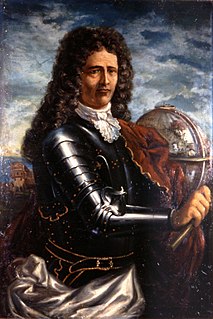 W
WDon José Antonio de Gaztañeta was a Spanish Basque ship-builder and sailor best remembered as the Vice-Admiral who commanded the Spanish Mediterranean fleet at the Battle of Cape Passaro against Great Britain on August 11, 1718, off the coast of Sicily. Gaztañeta's fleet was decisively defeated.
 W
WLuis González de Ubieta y González del Campillo was an admiral of the Spanish Republican Navy during the Spanish Civil War. He died in exile as the captain of merchant vessel Chiriqui, refusing to be rescued when the ship under his command sank in the Caribbean Sea not far from Barranquilla.
 W
WFederico Carlos Gravina y Nápoli was a Spanish admiral during the American Revolution and Napoleonic Wars. He died of wounds sustained during the Battle of Trafalgar. Spanish explorer Jacinto Caamaño named the Gravina Island in Alaska in his honor.
 W
WBaltasar Hidalgo de Cisneros y de la Torre (1756–1829) was a Spanish naval officer born in Cartagena. He took part in the Battle of Cape St Vincent and the Battle of Trafalgar, and in the Spanish resistance against Napoleon's invasion in 1808. He was later appointed Viceroy of the Viceroyalty of the Río de la Plata, replacing Santiago de Liniers. He disestablished the government Junta of Javier de Elío and quelled the Chuquisaca Revolution and the La Paz revolution. An open cabildo deposed him as viceroy during the May Revolution, but he attempted to be the president of the new government junta, thus retaining power. The popular unrest in Buenos Aires did not allow that, so he resigned. He was banished back to Spain shortly after that, and died in 1829.
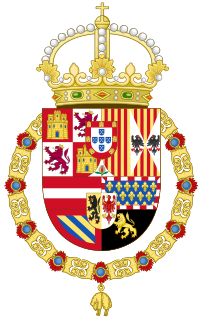 W
WJohn of Austria was an illegitimate son of Holy Roman Emperor Charles V. He became a military leader in the service of his half-brother, King Philip II of Spain, and is best known for his role as the admiral of the Holy Alliance fleet at the Battle of Lepanto.
 W
WJuan Francisco de Lángara y Huarte was a Spanish naval officer and Minister of Marine.
 W
WBlas de Lezo y Olavarrieta was a Spanish admiral best remembered for the Battle of Cartagena de Indias (1741) in modern-day Colombia, where Spanish imperial forces under his command resisted a siege by a large British invasion fleet under Admiral Edward Vernon. He has lately been promoted as one of the best strategists in naval history.
 W
WEnrique MacDonell, also spelled MacDonnell, was an Irish-Spanish admiral noted for his participation in several sea battles including the Battle of Trafalgar.
 W
WDon Jose de Mazarredo Salazar de Muñatones y Gortázar Order of Santiago was a Spanish naval commander, cartographer, ambassador, astronomer and professor of naval tactics. He is considered to be one of the best Spanish naval commanders of all time.
 W
WCasto Secundino María Méndez Núñez was a Spanish naval officer born in Vigo, Galicia. In 1866 during the Chincha Islands War between Spain, Peru and Chile, he was general commander of the Spanish fleet in the Pacific. As such, he bombarded and destroyed the port of Valparaiso, and fought the Battle of Callao Méndez Núñez was the first man to circumnavigate the world on an ironclad warship: "Enloricata navis quae primo terram circuivit".
 W
WPedro Menéndez de Avilés was a Spanish admiral and explorer from the region of Asturias, Spain, who is remembered for planning the first regular trans-oceanic convoys and for founding St. Augustine, Florida, in 1565. This was the first successful Spanish settlement in La Florida and the most significant city in the region for nearly three centuries. St. Augustine is the oldest continuously-inhabited, European-established settlement in the continental United States. Menéndez de Avilés was also the first governor of Florida (1565–74).
 W
WRear Admiral Patricio Montojo y Pasarón was a career Spanish naval officer who commanded the restored Kingdom of Spain's Pacific Squadron based in the Philippines during the Spanish–American War. Considered to have been a man of high ability and experience, he was given what was regarded as the impossible task of defending the Spanish Philippines with antiquated ships and low supplies against the more formidable U.S. Asiatic Squadron. Montojo became known for his defeat at the Battle of Manila Bay by U.S. Navy Commodore George Dewey, which was a decisive naval battle of the war. He was later held accountable for the defeat and was court-martialed. Although the decision was later overturned, Montojo was still discharged from the Spanish Navy.
 W
WJuan José Navarro y Búfalo, 1st Marquess of Victoria, OSJ was a Spanish military officer and first Captain General of the Spanish Navy.
 W
WAntonio de Oquendo was a Spanish admiral; in 1639 he was in command of the Spanish forces at the Battle of the Downs.
 W
WMiguel de Oquendo y Segura, was a Spanish Admiral. Born in San Sebastián (Gipuzkoa) in 1534, died at sea in 1588 when returning from the Spanish Armada campaign.
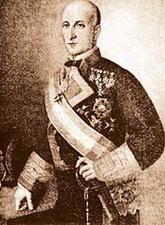 W
WVice Admiral José Manuel de Pareja y Septien was a Spanish naval officer, who commanded the Spanish forces during the Chincha Islands War (1864-1866).
 W
WAlonso Pérez de Guzmán y de Zúñiga-Sotomayor, 7th Duke of Medina Sidonia, was a Spanish aristocrat who was most noted for his role as commander of the Spanish Armada that was to attack the south of England in 1588.
 W
WCaptain Ramón Power y Giralt, commonly known as Ramón Power, was, according to Puerto Rican historian Lidio Cruz Monclova, among the first native-born Puerto Ricans to refer to himself as a "Puerto Rican" and to fight for the equal representation of Puerto Rico before the Cortes of Cádiz, the parliamentary government of Spain at the time.
 W
WRamón de Bonifaz was a medieval Spanish naval leader best known for breaking a river barricade leading to the capture of Seville from the Moors.
 W
WManuel Rebollo García is a Spanish Navy admiral. He became Chief of the Naval Staff on 18 July 2008. Admiral Jaime Muñoz-Delgado replaced him on 27 July de 2012.
 W
WAdmiral Juan Martínez de Recalde, KOS was a Spanish Navy officer who was named admiral of the fleet and second-in-command of the Spanish Armada, and commanded the San Juan de Portugal. He was a knight of the Order of Santiago.
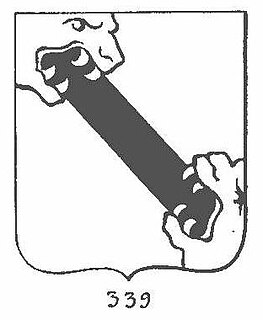 W
WFernando (or Fernán) Sánchez de Tovar, 1st Lord of Belves was a significant Castilian soldier and Admiral of the Middle Ages.
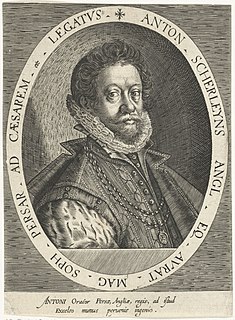 W
WSir Anthony Shirley (1565–1635) was an English traveller, whose imprisonment in 1603 by King James I caused the English House of Commons to assert one of its privileges—freedom of its members from arrest—in a document known as The Form of Apology and Satisfaction.
 W
WDon José de Solano y Bote Carrasco y Díaz, Marquess of Socorro, was a Spanish naval officer.
 W
WVicente Tofiño de San Miguel y Wanderiales was a Spanish navigator and cosmographer.
 W
WJuan Bautista Topete y Carballo, Spanish admiral and politician.
 W
WCayetano Valdés y Flores Bazán (1767–1835) was a commander of the Spanish Navy, explorer, and captain general who served in the French Revolutionary and Napoleonic Wars, fighting for both sides at different times due to the changing fortunes of Spain in the conflict. He took part in a number of naval battles, including the Great Siege of Gibraltar, the Battle of Cape St Vincent, and the Battle of Trafalgar. He was an explorer, most notable in the Pacific Northwest, where he and Dionisio Alcalá Galiano conducted the first circumnavigation of Vancouver Island, in partial cooperation with George Vancouver. Over his long career he achieved the highest ranks in the Spanish Navy, eventually being named Captain General of Cadiz and Captain General of the Spanish Navy.